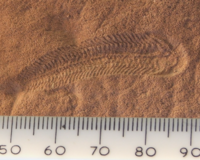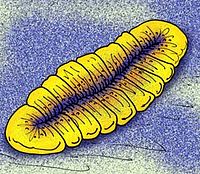Proarticulata
| Proarticulata | ||||
|---|---|---|---|---|

Dickinsonia rex (above), Archaeaspinus and other proarticulata |
||||
| Temporal occurrence | ||||
| Ediacarium | ||||
| 558 to 550 million years | ||||
| Systematics | ||||
|
||||
| Scientific name | ||||
| Proarticulata | ||||
| Fedonkin , 1985 | ||||
| Classes | ||||
The Proarticulata are an extinct tribe of the animal kingdom with supposed bilateral symmetry that was widespread in the late Ediacarian .
etymology
The name Proarticulata is derived from the ancient Greek prefix προ pro- ("before", "before") and the Latin articulata ("articulated animals"), which is derived from articulus ("small joint", "limb"), the diminutive of artus , derives. Meant so are the precursors of arthropods - animals with true segmentation such as annelids (Annelida) and arthropods (Arthropoda).
Initial description
The stem of the Proarticulata was first established in 1985 by Mikhail Alexandrowitsch Fedonkin for the taxa Dickinsonia , Vendia , Onega and Praecambridium . It currently includes many more taxa (see list below).
morphology
The proarticulata are divided transversely into so-called isomers . These differ from the segments in annelids and arthropods in their arrangement. Strictly speaking, individual isomers can only be found on one side of the body, since the isomers on the other side are periodically offset by gliding on the body axis. As a result, the isomers on the other side are not identical (due to reflection ), but offset by half an isomer width, which creates chirality (different right and left sides).
Taxonomy
Vendiamorpha
In the Vendiamorpha , the body is completely segmented into isomers that are bent backwards. The first isomer is usually much larger than the rest. The first two isomers are partially fused together at the anterior dorsal end (see illustration). Examples are Vendia , Paravendia and Karakhtia .
Cephalozoa (provisional name)
These proarticulates have incomplete segmentation because the front section has no isomers - the structure is somewhat similar to a hair band. Examples of Cephalozoa are Yorgia , Praecambridium , Andiva , Archaeaspinus , Ivovicia , Spriggina , Marywadea and Cyanorus . Some Cephalozoa from the family of Yorgiidae have a pronounced asymmetry of their left and right sides of the body. For example, the first isomer on the right side of the body spreads far to the left. Archaeaspinus even has an unpaired anterior segment that is only delimited by a furrow on the left side.
Dipleurozoa
The Dipleurozoa have a subradial structure and are completely divided into isomers. Examples are Dickinsonia and Phyllozoon . Juvenile Dickinsonia have an isomer-free front part, so the missing isomers must have been reduced in the course of Dickinsonia's ontogeny . Dickinsonia-like proarticulata then changed so radically in the course of their individual development that their adult forms were finally almost completely absorbed by isomers.
Proarticulata incertae sedis
In Onega stepanovi and Tamga hamulifera , all isomers are girdled by an undivided edge zone. With Onega stepanovi , the isomers stay in contact with one another, so that an area comparable to a float is created. In Tamga hamulifera , the isomers are separate from one another and do not touch one another. In Lossinia there is an undivided area in the central part and no isomers can be recognized. Rather, the lobe-like isomers proceed from the edge of the non-subdivided area as transverse links.
Listing of Proarticulata Body Fossils
- Armillifera Fedonkin , 1980
- Armillifera parva Fedonkin , 1980
- Andiva Fedonkin , 2002
- Andiva ivantsovi Fedonkin , 2002
- Archaeaspinus Ivantsov , 2007 (= Archaeaspis Ivantsov , 2001)
- Archaeaspinus fedonkini Ivantsov , 2001
- Chondroplon Wade , 1971 (possibly equivalent to Dickinsonia )
- Chondroplon bilobatum calf , 1971
- Cyanorus Ivantsov , 2004
- Cyanorus singularis Ivantsov , 2004
- Dickinsonia Sprigg , 1947
- Dickinsonia costata Sprigg , 1947
- Dickinsonia lissa Wade , 1972
- Dickinsonia menneri Keller , 1976 (= Vendomia menneri Keller , 1976)
- Dickinsonia rex Jenkins , 1992
- Dickinsonia tenuis Glaessner and Wade , 1966
- Ivovicia Ivantsov , 2007
- Ivovicia rugulosa Ivantsov , 2007
- Karakhtia Ivantsov , 2004
- Karakhtia nessovi Ivantsov , 2004
- Lossinia Ivantsov , 2007
- Lossinia lissetskii Ivantsov , 2007
- Marywadea Glaessner , 1976
- Marywadea ovata Glaessner and Wade , 1966
- Onega Fedonkin , 1976
- Onega stepanovi Fedonkin , 1976
- Ovatoscutum Glaessner and Wade , 1966
- Ovatoscutum concentricum Glaessner and Wade , 1966
- Paravendia Ivantsov , 2004
- Paravendia janae Ivantsov , 2001 (= Vendia janae Ivantsov , 2001)
- Phyllozoon Jenkins and Gehling , 1978
- Phyllozoon hanseni Jenkinsund Gehling , 1978
- Podolimirus Fedonkin , 1983
- Podolimirus mirus Fedonkin , 1983
- Praecambridium Glaessner and Wade , 1966
- Praecambridium siggilum Glaessner and Wade , 1966
- Spriggina Glaessner , 1958
- Spriggina floundersi Glaessner , 1958
- Tamga Ivantsov , 2007
- Tamga hamulifera Ivantsov , 2007
- Valdainia Fedonkin , 1983
- Valdainia plumosa Fedonkin , 1983
- Vendia Keller , 1969
- Vendia sokolovi cellar , 1969
- Vendia rachiata Ivantsov , 2004
- Windermeria Narbonne , 1994
- Windermeria aitkeni Narbonne , 1994
- Yorgia Ivantsov , 1999
- Yorgia waggoneri Ivantsov , 1999
Trace fossils
- Epibaion Ivantsov , 2002
- Epibaion axiferus Ivantsov , 2002
Individual evidence
- ^ MA Fedonkin: Systematic Description of Vendian Metazoa . Ed .: Sokolov, BS and Iwanowski, AB, Vendian System: Historical-Geological and Paleontological Foundation, Vol. 1: Paleontology. Nauka, Moscow 1985, p. 70-106 .
- ↑ Fedonkin, MA: The origin of the Metazoa in the light of the Proterozoic fossil record . In: Paleontological Research . tape 7 (1) , 2003, p. 9-41 , doi : 10.2517 / prpsj.7.9 .
- ^ A b Ivantsov, AY: Vendia and Other Precambrian "Arthropods" . In: Paleontological Journal . tape 35 (4) , 2001, p. 335-343 .
- ↑ Ivantsov, AY: Vendian Animals in the phylum proarticulata. The Rise and Fall of the Vendian Biota . In: IGSP Project 493. Abstracts . Prato, Italy 2004, p. 52 .
- ^ A b c Ivantsov, AY: New Proarticulata from the Vendian of the Arkhangel'sk Region . In: Paleontological Journal . tape 38 (3) , 2004, p. 247-253 .
- ↑ Ivantsov, AY: A New Dickinsoniid from the Upper Vendian of the White Sea Winter Coast (Russia, Arkhangelsk Region) . In: Paleontological Journal . tape 33 (3) , 1999, pp. 233-241 .
- ↑ a b c d e Ivantsov, AY: Small Vendian transversely Articulated fossils . In: Paleontological Journal . tape 41 (2) , 2007, pp. 113 , doi : 10.1134 / S0031030107020013 .
- ↑ Ivantsov, AY and Malakhovskaya, YE: Giant Traces of Vendian Animals . In: Doklady Earth Sciences . tape 385 (6) , 2002, pp. 618-622 .
- ↑ Fedonkin, MA: Andiva ivantsovi gen. Et sp. n. and related carapace ‐ bearing Ediacaran fossils from the Vendian of the Winter Coast, White Sea, Russia . In: Italian Journal of Zoology . tape 69 (2) , 2002, pp. 175-181 , doi : 10.1080 / 11250000209356456 .
- ^ A b B. M. Keller and MA Fedonkin: New Records of Fossils in the Valdaian Group of the Precambrian on the Syuz'ma River . In: Izv. Akad. Nauk SSSR, Ser. Geol. (In Russian) . tape 3 , 1976, p. 38-44 .
- ^ Narbonne, GM: New Ediacaran fossils from the Mackenzie Mountains, northwestern Canada . In: Journal of Paleontology . tape 63 (3) , 1994, pp. 411-416 .
- ↑ Ivantsov, AY: Feeding traces of Proarticulata - the Vendian metazoa . In: Paleontological Journal . tape 45 (3) , 2011, p. 237-248 , doi : 10.1134 / S0031030111030063 .











